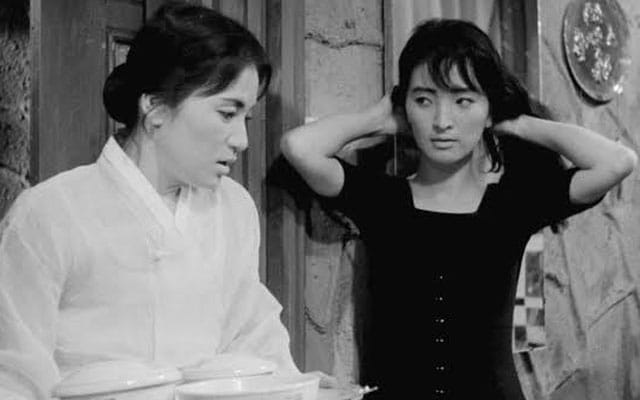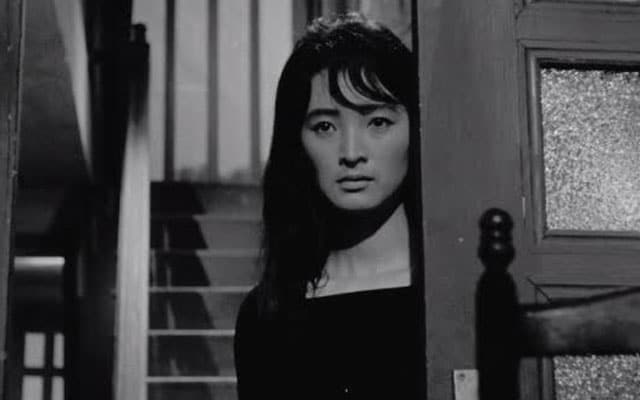Kim Ki-young’s landmark 1960 South Korean drama The Housemaid, which influenced Bong Joon-ho’s Parasite formally and thematically, is now available for streaming on MUBI.
When asked to describe his Palme d’Or and Oscar-winning thriller Parasite, Bong Joon-ho called it his “stairway movie,” a rich and long tradition of movies that use verticality to reinforce social divide and class conflict. The South Korean writer-director cited two “stairway movies” in particular as sources of inspiration. One was Joseph Losey’s The Servant (1963), which is now streaming on MUBI. The other was Ki-young’s The Housemaid (1960), which was restored by Martin Scorsese’s World Cinema Project and is also now streaming on MUBI.
Watching The Housemaid, The Servant and Parasite one after the other, the formal and thematic parallels are hard to ignore. All three films are home invasion thrillers that double as class allegories. All three are set almost entirely in a single house which acts as a microcosm of the larger society and its failings. Characters in all three are frequently going up and down the stairs — a recurring visual motif of social mobility and the insurmountable gulf between the classes.
A still from The Housemaid
Given its recent arrival on MUBI, the focus of this article is on The Housemaid. Similar to Parasite, Ki-young’s drama begins with an infiltration. Kim Dong-sik (Kim Jin-kyu) is a piano teacher on the upward climb. He hires the young maid Myung-sook (Lee Eun-shim) to ease the strain on his wife (Ju Jeung-ryu) who is pregnant with their third child. When Myung-sook turns out to be a femme fatale, middle-class stability is threatened. Mr. Kim initially resists her sexual advances but eventually relents. Myung-sook becomes pregnant. The bourgeois façade breaks down, and their lives descend into a domestic nightmare.

The Housemaid
The year 1960 was a period of transition in South Korea. The autocratic reign of its first president Syngman Rhee had been brought to an end by a student revolt, but the country was still a few decades away from becoming the industrial superpower we now know it as. Industries at the time prospered by taking advantage of the low-wage labour of young unmarried women. Moreover, oppressive gender roles limited women’s economic security. The anxieties of the post-war middle and lower classes thus loom all over The Housemaid. The Kims are eager to fulfil their bourgeois dreams — a big house, a TV and the luxury of hired help — even if they can’t afford it. The cracks that already existed in the Kim household swell upon Myung-sook’s arrival.
The film opens not in the Kim household, but in the local factory where Mr. Kim leads a small choir of young women. If these women flirt with him despite being married, the desire comes as much from a place of economic despair as anything else. Finding a suitable man is an economic proposition after all. When Mr. Kim offers them private lessons to pay for the improvements in his two-storey home, one of the factory girls, Kyung-hee Cho (Um Aing-ran), accepts with a grander design in mind — the same as Myung-sook.
If Myung-sook leverages the affair to keep her job and the pregnancy to improve her position in the house, the Kims will resort to any measure to regain control over the household. In an attempt to save face and her marriage, Mrs. Kim compels Myung-sook to throw herself down the stairs to abort the baby. Grief over the miscarriage however causes Myung-sook to launch an all-out offensive against the Kims. This isn’t a straightforward master-servant interplay. Roles switch as each party tries to gain the upper hand. As the battle between the maid and the bourgeoisie heats up, there will be more victims.

The Housemaid
Kim Deok-jin’s framing and Han Sang-gi’s orchestral score set a claustrophobic mood right from the beginning. The tension tightens on Myung-sook’s arrival in the Kim household, a place that starts to feel like a prison. The characters, imprisoned not only in a place but by the roles they are forced to play, give in to the melodrama and madness. Where Parasite benefits from smoothly calibrated tonal shifts and deftly choreographed set pieces, The Housemaid gains its potency through melodrama in service of satire. Ki-young’s penchant for melodrama though weakens the hold sometimes, leaving the film struggling to sustain the same level of tension throughout.

The Housemaid
This is a film rich in symbolism. A string game of cat’s cradle, which the two Kim kids play in the beginning, foreshadows the tangled web the characters get caught in. A bottle of rat poison, the use of light and shadow, and the raging rain, thunder and lightning create an ominous atmosphere. The staircase of course is its most potent symbol: of the triumphs of the capitalist classes built on the toil of the working classes. From Mr. Kim’s perspective, if upstairs symbolises sin and temptation, downstairs symbolises family and domesticity. The staircase is the in-between place where things can go either way, a locus of shifting power dynamics. Stairs aside, windows and doors mark out visual lines of social distinctions. When lines are crossed, we know it. Myung-sook spies on and seduces Mr. Kim through discreet visits via the balcony that connects her room to the piano room. The mechanisms for the powerplays are thus written into the setting itself. The scramble of the ascent vs the ease of the descent shows just how much harder it is rise up the social ladder.
Everyone seeks a better life. The motivation is only natural. But Ki-young games out the consequences when it grows unnatural through a markedly conservative approach. That Miss Cho accuses Mr. Kim of rape when he rejects her or that Myung-sook smokes and seduces a married man are signalled as cautionary lessons against unchecked sexuality and the invasive impact of Western culture on South Korean society. That Mrs. Kim is ready to sweep her own son’s death under the rug if it means her husband will keep his job and she won’t lose her husband is signalled as a cautionary lesson against whatever-it-takes social climbing. Capitalist excesses are lamented in her last words — “Oh, if only I hadn’t wanted a new house” — before the anti-climactic epilogue.
In any country where economic inequality breeds unhealthy competition, the combination of focus, hard work and resiliency as a sure-fire route to upward mobility is drilled into our heads right from childhood. In the Kim household, Mr. Kim urges his daughter, who suffers from an unspecified illness that requires her to walk with crutches, to get stronger, despite the hurtful taunts of his younger son. He buys her a squirrel to serve as an everyday reminder of how the animal doesn’t let its caged existence prevent it from exercising its limbs on the running wheel. Elsewhere, Mrs. Kim works hard on the sewing machine to the point of exhaustion for supplemental income. The wheel must keep turning when the end goal is social mobility.
The Housemaid (1960) is now streaming on MUBI.
Prahlad Srihari is a film and music writer based in Bengaluru.
Read all the Latest News, Trending News, Cricket News, Bollywood News, India News and Entertainment News here. Follow us on Facebook, Twitter and Instagram
